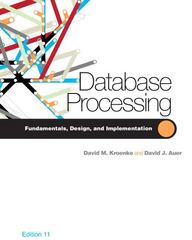Question
Write C++ Code sample code // Created by Y. Wu, Jan 31, 2023 // You are given an input containter (of any STL set/vec/etc) of
Write C++ Code
 sample code
sample code
// Created by Y. Wu, Jan 31, 2023
// You are given an input containter (of any STL set/vec/etc) of certain type (e.g., int, string, etc), a container of forbidden items (which may be any STL container type, and so may not be sorted), and a new censored value (of the same type). You are to output (STL container of the same type) the sorted list of items from the input such that this list contains all the items from the input, and any value appearing in the forbidden list is converted to the censored value.
// For example, suppose the input: [1 -1 2, 5, 2], forbidden list [-1], censored value = 0, then the output is: [0, 1, 2, 2, 5]
// Now define the function ECCensor ...
test code
// Test ECCensor. To compile: c++ ECCensorTest.cpp -o test
#include "ECCensor.cpp"
#include
#include
#include
#include
using namespace std;
template
void ASSERT_EQ(T x, T y)
{
if( x == y )
{
cout
}
else
{
cout
}
}
void Test1( )
{
vector
vecIn.push_back(1);
vecIn.push_back(-1);
vecIn.push_back(2);
vecIn.push_back(5);
vecIn.push_back(2);
vector
listForbidden.push_back(10);
listForbidden.push_back(-1);
vector
ECCensor(vecIn, listForbidden, 0, listOuts );
ASSERT_EQ((int)listOuts.size(), 5);
ASSERT_EQ(listOuts[0], 0);
ASSERT_EQ(listOuts[1], 1);
ASSERT_EQ(listOuts[2], 2);
ASSERT_EQ(listOuts[3], 2);
ASSERT_EQ(listOuts[4], 5);
}
int main()
{
Test1();
}
1 Merging containers You are to implement a function called ECMergeContainers, which takes two parameters: (i) a list (container) of some lists (containers), and (ii) a container for output. Here, container is a STL container e.g., vector, set, etc. ECMergeContainers will merge all the lists of containers into a single container (which should be sorted). 1. Your code must be as flexible as possible. That is, you should allow different kinds of STL containers to be the input and output. 2. Your code must be concise: use no more than 10 lines of code inside the function! 3. For output, some containers allow duplicates and you should keep the duplicate. If the output container doesn't allow duplicate (like set), then it is OK to discard duplicate
Step by Step Solution
There are 3 Steps involved in it
Step: 1

Get Instant Access to Expert-Tailored Solutions
See step-by-step solutions with expert insights and AI powered tools for academic success
Step: 2

Step: 3

Ace Your Homework with AI
Get the answers you need in no time with our AI-driven, step-by-step assistance
Get Started


